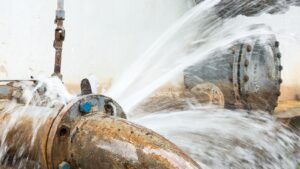When addressing the intricate issues of managing water resources, spatial data management systems like Geographic information systems (GIS) can efficiently take into account the geographical variability of soil, crop, water supply, and environment. Integrating geographic information system technology into water canals is a strategic decision as it would handle issues and boost workflow effectiveness to advance water canal functionality. Effective management of water and land resources for irrigation is made possible by geographic information systems and remote sensing (RS). In order to improve water usage efficiency, irrigation water management will undergo a technical transformation as a result of the future potential of GIS and RS applications for sustainable irrigation water management. Geographical Information Systems are capable of acquiring, storing, manipulating, controlling, and analysing geographically-referenced datasets and creating output. They have evolved to solve diverse spatial and temporal difficulties in irrigation and water resource management. It is therefore a crucial instrument in the processes of resource allocation, modelling, optimisation, and decision-making. GIS is a useful and potent tool for identifying changes in land use and cover. GIS has been used in conjunction with other techniques to comprehend crop identification, crop area estimation, soil conditions, pest infestation, prospective yield, and agricultural water management. Read on to discover other areas of importance that GIS has in water canal management.
The Various Advantages of GIS Tools in Water Canal Assets
Utilising a range of satellite technologies, including, Earth Observation (EO) imagery and communications, water asset managers are realising the potential of satellite technology in the water industry. Here are 4 ways in which satellite technology can optimise this sector:
Predicting Maintenance for Water Canal Systems
Water canals need to be maintained to ensure that they can meet the industry’s standards and guarantee public safety. This is why it is crucial to carry out routine checkups on every water asset. At one point, a team has to be dispatched to assess the health of assets. Water canal managers have begun to automate this as it becomes time-consuming by using IIoT sensors, Artificial Intelligence (AI), Machine Learning (ML), and a variety of other cutting-edge technology. GIS evaluates which assets are in critical condition using the data from all such devices. To identify any potential anomalies in the future, good technology vendors will combine predictive and prescriptive analytical tools into their water canal systems. Managers may be alerted to potential breakdowns as a result. GIS reflects the requirement for such assets to be the upkeep in its digital map hierarchically using these insights. In other words, it will highlight the asset that needs the most attention and tag upkeep as such. An overview of the required maintenance can then be obtained by a water asset manager.
Executing Data-Driven Analysis To Accommodate Your Needs
GIS can quickly analyse vast volumes of data and display crucial data and insights on a smart screen that is interactive. However, if all GIS did was merely give all the data it receives from other sensors, it might be meaningless. The map would get cluttered as a result, necessitating the use of humans to perform the crucial tasks of examining, analysing, and making decisions. GIS has been acknowledged as the ideal answer for water canal managers as it doesn’t rely on specialised or human experts. AI and ML technologies are used to derive all data-driven insights, and managers can rely on them to act quickly to fix any flaws. As a result, GIS only displays the data that the manager needs. For instance, it will only offer details if the manager requests to check asset conditions. Assume, however, that the management is forced to choose between maintaining two crucial assets because of a lack of funding. In that situation, the system can offer insights about the asset based on aspects other than only the asset’s status, such as how frequently the public utilises it. Additionally, GIS may use data to assist asset managers in determining the optimal path for maintenance and offer damage analysis reports using remote sensing.
Making Use Of A Disaster Preparedness Strategy
Weather patterns and conditions can be recognised by GIS. Thus, when a natural disaster is approaching, GIS will monitor the changing climate and represent it on the map. It will give water canal managers plenty of notice of the anticipated severity of the disaster and the affected areas. This is an excellent way to protect the public and think through any preparations that may be put in place to preserve assets. Therefore, asset managers can inform local authorities in cases where evacuation is necessary of the insights gained by GIS. This data can be used by engineers to run simulations when designing assets. They can assess the asset’s durability and make sure it is designed to resist such disasters by incorporating that data into tools like digital twins. Governmental asset managers use GIS maps to integrate, compile, analyse, and plot asset data and to take advantage of AI-driven geolocational asset insights. This technology is a particularly valuable tool for government use because it encourages civic participation, which enables governments to gain deeper insights into water canal systems.
Improved Efficiency of Water Canal System Management
A number of problems that irrigated agriculture is dealing with have led to subpar performance, inefficient water use, and low crop water production. GIS may be used to precisely map irrigated areas, which is essential for obtaining irrigation precision, in addition to appraising land for irrigation. To find irrigated areas, data is collected from satellites like MODIS, LandSat, and AVHRR. In order to categorise irrigated and non-irrigated areas and to evaluate spatiotemporal fluctuations in irrigation, spectral patterns of the data are analysed. This is accomplished by comparing various land use and land cover types to the spectral reflectance notion. Maps of soil salinity, groundwater potential, and irrigation infrastructure have all been created using GIS. Improving water use efficiency in irrigated agriculture necessitates using technology that decreases water losses, matches available supplies to demand, and tracks the performance of water canals. Integrated management of surface and groundwater resources can increase water use effectiveness, increase agricultural production, and reduce water logging in large canal irrigation project regions.
Tigernix Beating to It in the Water Industry
Tigernix GIS Technology benefits users of our patented technology in two areas in particular. First, by recognising and estimating the consequences of looming disasters, such as landslides, bushfires, and floods, and the resources needed for recovery before they happen, such as ensuring security, detailing risks and dangers, tracking building progress, and more.
Advance Your Water Canal System Without a Hitch
GIS is an effective tool for managing, storing, and displaying dimensional data usually capable of water resources management and is vital for the continuous analysis of water canal systems. GIS can help propel your water canal system to function to its full potential without compromising the health or quality of water. Do not miss out on the many advantages that this technology has to provide, and integrate GIS into your water canal asset today.







